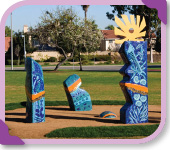“Water Henge: H2O = Life”
Updated January 25, 2023
“Water Henge: H2O = Life” is located at Don Knabe Community Regional Park. The piece was commissioned by the City of Cerritos and Los Angeles County and was created by artist Kim Emerson. The artwork is made up of five mosaic landscape sculptures that represent a visual timeline of the presence of water, or lack of water, in the region. The pieces range in size from 9 inches high to 15 feet high. Each sculpture is carved out of Expanded Polystyrene (EPS). The forms were imbedded with a steel armature, rebar frame and coated with one-inch thick cement. Ceramic mosaic tiles accented with glass pieces surround the cement.
Each sculpture, using detailed ceramic tile mosaics, tells the story of how the Los Angeles Basin was once affected by large amounts of water over 250,000 million years ago. Sculpture One represents the ocean and the prehistoric life forms found underwater millions of years ago. This sculpture is crowned with a gold painted metal element representing a sun with a hole in the center, called the “sun catcher.”
Geologically, after the eastern mountain range pushed upward, the ocean receded and the area became marshlands where dinosaurs roamed. Sculpture Two’s mosaics depict found dinosaur bone fossils and vertebrae shapes.
As the mountains continued to rise and the sun warmed the earth, the landscape dried into flat fields that held less water but were ideal for the migration of animals and Native Americans. Sculpture Three appears to have eroded further over time, and features a mosaic of animal paw prints and human footprints.
The shape of Sculpture Four is the most eroded and appears to be melting into the earth. The piece’s mosaic includes images of fossilized plant life.
Sculpture Five is the smallest piece. It represents the minimal amount of water available today compared to the abundance of water found in the region millions of years ago. It also represents the four directions.
The entire series of sculptures in their arrangement creates a life-size sundial.






